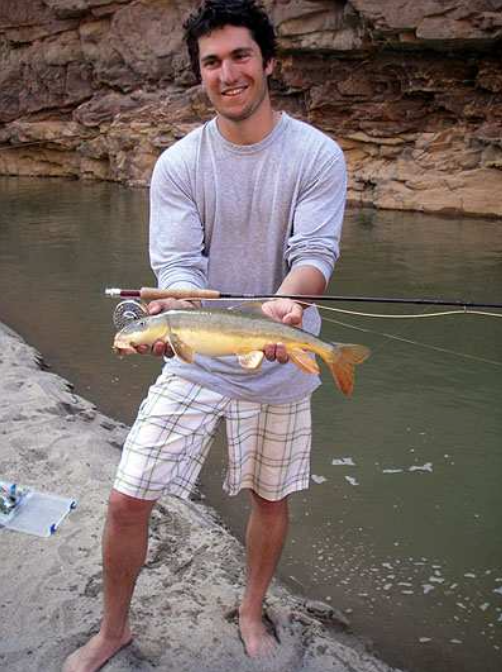We reached Winnie’s Rapid in the Canyon of Lodore near noon. As we got off of our rafts and set foot onto the long sandbar in front of us, we noticed something fairly strange. Everywhere we looked, there were Mormon Crickets. These large red insects, which are actually a shieldbacked katydid and not a true cricket, were crawling all over the sandbar in the hundreds. As we unpacked our gear, started to survey for our projects, and ate lunch, we managed to displace a few of them from whatever activity had brought them to this particular place. Some began to move towards the vegetated edges of the sandbar, while others simply jumped into the river, or tried to leap onto the rocky cliff that surrounded us and fell into a backwater section nearby. Still others stood in place and happily shared the sandbar with us.
After our daily activities had settled down a bit, some of the students noticed large numbers of crickets floating in a backwater section along the upstream edge of the sandbar. Here the water cut deeply between the edges of the sandbar and the face of the cliff in front of it. The clarity of the water was somewhat murky, though visibility remained steady at around 1.5 feet. Many crickets began to flow by as the daily water release from the dam brought a current to the area, and raised the water level along the banks of the backwater. Then to our surprise, and with a sudden splash, a cricket we were watching disappeared. All of the fishermen in the group suddenly realized the golden opportunity before us.
The eddy and deeply cut backwater section not more than 20 feet wide at the edge of our camp where we were watching crickets float by, was teaming with fish. Rods were bolted in, knots tied firmly, hooks baited, and flies were found to “match the hatch.” Hours later we had sampled these waters and to our surprise, we had caught many fish in this small area all on crickets. Extremely puzzling however, were fish species such as the Flannel Mouth sucker that were caught on crickets, fished floating along the surface. It seemed that nearly all of the fish in the area, regardless of species, realized the presence of these crickets and their potential as meals.

Flannel-Mouth Sucker taken on a large cricket dry-fly.
Further sampling proved a near 100% reliance on these insects, when we opened the gut contents of the large trout and catfish we caught later that evening. Surprisingly, one trout had managed to gorge on 15 large Mormon Crickets, which stretched his stomach capacity to its limits. When they arrive, these terrestrial insects provide a large dietary supplement to an already extremely abundant aquatic system for fish to eat. (See also the report about fish of the Green River from this class for more information.)

Who says the A-section has the best fishing?
